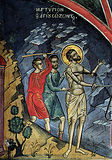

| Previous day | Next day |
| Old Style
September 7
|
Thursday |
New Style
September 20
|
| 17th Week after Pentecost. Tone 7. | No fast.
|
![]() Forefeast of the Nativity of the Theotokos.
Forefeast of the Nativity of the Theotokos. ![]() Martyr Sozon of Cilicia (304).
Martyr Sozon of Cilicia (304). ![]() St. John, archbishop and wonderworker, of Novgorod (1186).
St. John, archbishop and wonderworker, of Novgorod (1186). ![]() Hieromartyr Macarius of Kanev, archimandrite, of Obruch and Pinsk (1678). St. Macarius, elder, of Optina Monastery (1860).
Hieromartyr Macarius of Kanev, archimandrite, of Obruch and Pinsk (1678). St. Macarius, elder, of Optina Monastery (1860).
Apostles Evodus (Euodias) (66) and Onesiphorus (67), of the Seventy. Martyr Eupsychius of Caesarea in Cappadocia (ca. 130). St. Luke and St. Peter the Cappadocian, abbots, of the monastery of the Deep Stream (10th c.). Sts. Alexander (Peresvet) and Andrew (Oslyabya), disciples of St. Sergius of Radonezh, who fought at the Battle of Kulikovo (1380). St. Serapion of Spaso-Eleazar Monastery, Pskov (1480)
New Hieromartyrs Eugene (Zernov), metropolitan of Nizhni- Novgorod, Leo (Yegorov), archimandrite, of the St. Alexander Nevsky Lavra, Nicholas (Ashchepev), abbot, of the Holy Trinity Selinginsk Monastery, Eugene (Vyzhva), abbot, of Zhitomir (Ukraine), Pachomius (Ionov), hieromonk of the Holy Trinity Skanov Monastery (Penza), and Stephen (Kreidich), priest, of Robchik (Bryansk) (1937). New Hieromartyr John Maslovsky, priest, of Verkhne-Poltavka, Amur (1921).
Sts. Symeon (1476) and Amphilochius (1570), of Pangarati Monastery (Romania). St. Cloud (Clodoald), founder of Nogent-sur-Seine Monastery, near Paris (560). St. Cassia (Cassiana) the Hymnographer (9th c.).
Repose of Metropolitan Isidore (Nikolsky) of St. Petersburg (1892) and Archbishop Anatole (Kamensky) of Irkutsk (1925).
Thoughts for Each Day of the Year
According to the Daily Church Readings from the Word of God
By St. Theophan the Recluse

Thursday. [Eph. 4:14-19; Mark 11:27-33]
The Saviour proves that He was sent from heaven using the testimony of John the Forerunner. They were silent, for there was nothing to say to the contrary, yet they did not believe. Another time He proved the same thing through His deeds, and they thought up a new twist: [He casteth out devils] by the prince of the devils (Mt. 9:34, Mk. 3:22). But when this twist was exposed to be completely inappropriate, they again were silent, but nevertheless did not believe. Thus unbelievers never believe no matter what you tell them and how convincingly you prove the truth. They cannot say anything to the contrary, while nevertheless they do not believe. One might say that their mind is paralyzed, since they reason sensibly about other things. Only when the issue touches upon faith do they become confused in their concepts and words. They also become confused when they present their outlooks as a substitute for the tenets of faith given by God. Here their doubt raises such a buttress that it is like a firm cliff. If you hear their entire theory through, you will see that a child could figure out that this is a spider’s web; but they do not see it. O unfathomable blindness! One can explain the obstinacy of unbelievers as their not wanting to believe, but where does this come from? Where does it get such power that it makes a sensible man consciously cling to an illogical form of thoughts? This is darkness. Is it not from the father of darkness?
Articles
 Martyr Macarius the Archimandrite of Kanev and PereyaslavlThe Hieromartyr Macarius of Kanev lived in the seventeenth century. This was a most terrible time for Orthodox Christians in western Rus. |
 Apostle Evodius (Euodias) of the SeventyThe Holy Apostle Evodius of the Seventy was, after the holy Apostle Peter, the first bishop in Syrian Antioch. |
 Apostle Onesiphorus of the SeventySaint Onesiphorus was bishop at Colophon (Asia Minor), and later at Corinth. |









